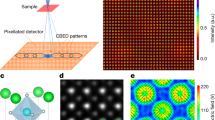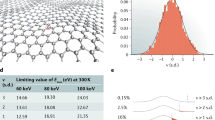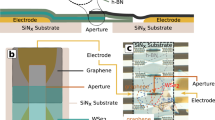Abstract
Direct imaging and chemical identification of all the atoms in a material with unknown three-dimensional structure would constitute a very powerful general analysis tool. Transmission electron microscopy should in principle be able to fulfil this role, as many scientists including Feynman realized early on1. It images matter with electrons that scatter strongly from individual atoms and whose wavelengths are about 50 times smaller than an atom. Recently the technique has advanced greatly owing to the introduction of aberration-corrected optics2,3,4,5,6,7,8. However, neither electron microscopy nor any other experimental technique has yet been able to resolve and identify all the atoms in a non-periodic material consisting of several atomic species. Here we show that annular dark-field imaging in an aberration-corrected scanning transmission electron microscope optimized for low voltage operation can resolve and identify the chemical type of every atom in monolayer hexagonal boron nitride that contains substitutional defects. Three types of atomic substitutions were found and identified: carbon substituting for boron, carbon substituting for nitrogen, and oxygen substituting for nitrogen. The substitutions caused in-plane distortions in the boron nitride monolayer of about 0.1 Å magnitude, which were directly resolved, and verified by density functional theory calculations. The results demonstrate that atom-by-atom structural and chemical analysis of all radiation-damage-resistant atoms present in, and on top of, ultra-thin sheets has now become possible.
This is a preview of subscription content, access via your institution
Access options
Subscribe to this journal
Receive 51 print issues and online access
$199.00 per year
only $3.90 per issue
Buy this article
- Purchase on Springer Link
- Instant access to full article PDF
Prices may be subject to local taxes which are calculated during checkout



Similar content being viewed by others
References
Feynman, R. P. in Feynman and Computation (ed. Hey, J. G.) 63–76 (Perseus Press, Cambridge, Massachusetts, 1999); text of original 1959 lecture also available at 〈http://feynman.caltech.edu/plenty.html〉 (2001)
Haider, M. et al. Electron microscopy image enhanced. Nature 392, 768–769 (1998)
Batson, P. E., Dellby, N. & Krivanek, O. L. Sub-ångstrom resolution using aberration corrected electron optics. Nature 418, 617–620 (2002)
Hawkes, P. W. ed. Aberration-Corrected Electron Microscopy (Advances in Imaging and Electron Physics, Vol. 153, Elsevier, 2008)
Girit, Ç. Ö. et al. Graphene at the edge: stability and dynamics. Science 323, 1705–1708 (2009)
Jia, C. L., Lentzen, M. & Urban, K. Atomic resolution imaging of oxygen in perovskite ceramics. Science 299, 870–873 (2003)
Muller, D. A. et al. Atomic-scale chemical imaging of composition and bonding by aberration-corrected microscopy. Science 319, 1073–1076 (2008)
Suenaga, K. et al. Visualizing and identifying single atoms using electron energy-loss spectroscopy with low accelerating voltage. Nature Chem. 1, 415–418 (2009)
Kisielowski, C. et al. Imaging columns of the light elements carbon, nitrogen and oxygen with sub Ångstrom resolution. Ultramicroscopy 89, 243–263 (2001)
Suenaga, K. et al. Element-selective single atom imaging. Science 290, 2280–2282 (2000)
Leapman, R. D. Detecting single atoms of calcium and iron in biological structures by electron energy-loss spectrum-imaging. J. Microsc. 210, 5–15 (2003)
Varela, M. et al. Spectroscopic imaging of single atoms within a bulk solid. Phys. Rev. Lett. 92, 095502 (2004)
Egerton, R. F. Electron Energy Loss Spectroscopy in the Electron Microscope 2nd edn (Plenum, 1996)
Miller, M. K. Atom Probe Tomography: Analysis at the Atomic Level (Kluwer Academic/Plenum, 2000)
Kelly, T. F. & Miller, M. K. Atom probe tomography. Rev. Sci. Instrum. 78, 031101 (2007)
Meyer, J. C., Chuvilin, A., Algara-Siller, G., Biskupek, J. & Kaiser, U. Selective sputtering and atomic resolution imaging of atomically thin boron nitride membranes. Nano Lett. 9, 2683–2689 (2009)
Jin, C., Lin, F., Suenaga, K. & Iijima, S. Fabrication of a freestanding boron nitride single layer and its defect assignments. Phys. Rev. Lett. 102, 195505 (2009)
Alem, N. et al. Atomically thin hexagonal boron nitride probed by ultrahigh-resolution transmission electron microscopy. Phys. Rev. B 80, 155425 (2009)
Crewe, A. V., Wall, J. & Langmore, J. Visibility of single atoms. Science 168, 1338–1340 (1970)
Hartel, P., Rose, H. & Dignes, C. Conditions and reasons for incoherent imaging in STEM. Ultramicroscopy 63, 93–114 (1996)
Zobelli, A., Gloter, A., Ewels, C. P., Seifert, G. & Colliex, C. Electron knock-on cross section of carbon and boron nitride nanotubes. Phys. Rev. B 75, 245402 (2007)
Issacson, M., Kopf, D., Ohtsuki, M. & Utlaut, M. Atomic imaging using the dark field annular detector in the STEM. Ultramicroscopy 4, 101–104 (1979)
Voyles, P. M., Muller, D. A., Grazul, J. L., Citrin, P. H. & Gossman, H.-J. L. Atomic-scale imaging of individual dopant atoms and clusters in highly n-type bulk Si. Nature 416, 826–829 (2002)
Midgley, P. A. & Weyland, M. 3D electron microscopy in the physical sciences: the development of Z-contrast and EFTEM tomography. Ultramicroscopy 96, 413–431 (2003)
Stephan, O. et al. Doping graphitic and carbon nanotube structures with boron and nitrogen. Science 266, 1683–1685 (1994)
Kawaguchi, M., Kuroda, S. & Muramatsu, Y. Electronic structure and intercalation chemistry of graphite-like layered material with a composition of BCB6BN. J. Phys. Chem. Solids 69, 1171–1178 (2008)
Hernandez, Y. et al. High yield production of graphene by liquid phase exfoliation of graphite. Nature Nanotechnol. 3, 563–578 (2008)
Krivanek, O. L. et al. An electron microscope for the aberration-corrected era. Ultramicroscopy 108, 179–195 (2008)
Acknowledgements
We thank L. M. Brown, J. N. Coleman, P. Rez and J. C. H. Spence for discussions. Research at Oak Ridge National Laboratory (M.F.C., T.J.P., M.P.O., S.T.P. and S.J.P.) was sponsored by the Division of Materials Sciences and Engineering of the US Department of Energy. Research at Vanderbilt was supported in part by the US Department of Energy grant DE-FG02- 09ER46554 and the McMinn Endowment. Computations were performed at the National Energy Research Scientific Computing Center at Lawrence Berkeley National Laboratory.
Author Contributions O.L.K. initiated the project and wrote the paper, M.F.C., N.D., O.L.K. and M.F.M. recorded preliminary experimental data, M.F.C. improved the imaging and recorded the data used in the paper, V.N. prepared the samples, O.L.K. and N.D. performed data processing and analysis, T.J.P. and S.T.P. performed DFT calculations, M.P.O. performed image calculations, S.J.P. initiated the aberration-corrected microscopy project at ORNL and advised on the paper, and G.J.C., N.D., O.L.K., M.F.M, C.S.O. and Z.S.S. designed and built the electron microscope. All the authors read and commented on the manuscript.
Author information
Authors and Affiliations
Corresponding author
Ethics declarations
Competing interests
G.J.C., N.D., O.L.K., M.F.M. and Z.S.S. have a financial interest in Nion Co.
Supplementary information
Supplementary Information
This file contains Supplementary Methods and Materials, Supplementary References and Supplementary Figures S1-S3 with legends. (PDF 836 kb)
Rights and permissions
About this article
Cite this article
Krivanek, O., Chisholm, M., Nicolosi, V. et al. Atom-by-atom structural and chemical analysis by annular dark-field electron microscopy. Nature 464, 571–574 (2010). https://doi.org/10.1038/nature08879
Received:
Accepted:
Issue Date:
DOI: https://doi.org/10.1038/nature08879
This article is cited by
-
Deep convolutional neural networks to restore single-shot electron microscopy images
npj Computational Materials (2024)
-
Two-dimensional few-atom noble gas clusters in a graphene sandwich
Nature Materials (2024)
-
Atomically engineering metal vacancies in monolayer transition metal dichalcogenides
Nature Synthesis (2024)
-
The reformation of catalyst: From a trial-and-error synthesis to rational design
Nano Research (2024)
-
Strain engineering in electrocatalysis: Strategies, characterization, and insights
Nano Research (2024)
Comments
By submitting a comment you agree to abide by our Terms and Community Guidelines. If you find something abusive or that does not comply with our terms or guidelines please flag it as inappropriate.



